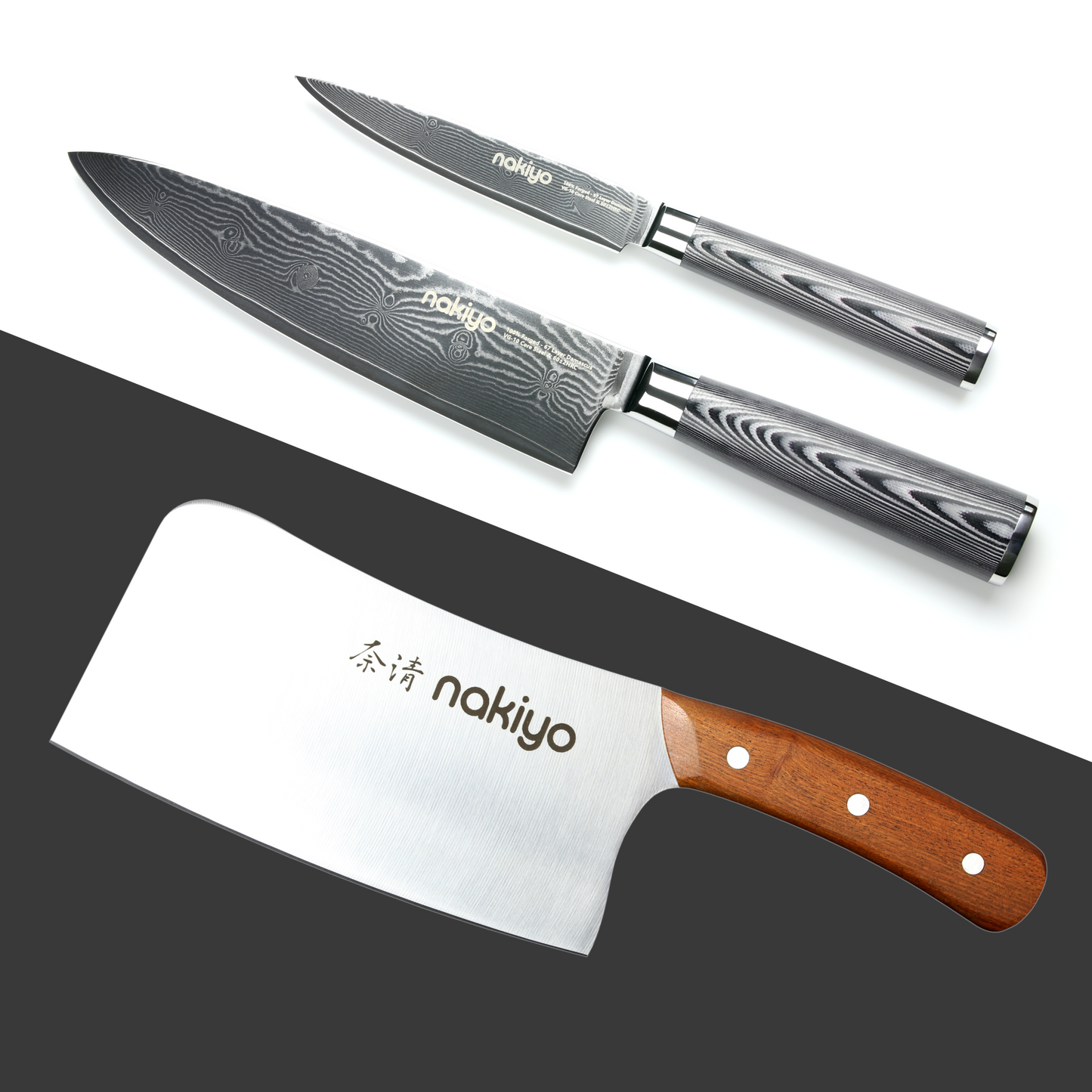Nakiyo Chopper Champion Bundle
Nakiyo Chopper Champion Bundle
In stock
Couldn't load pickup availability
Share
If you want both the rugged power of a cleaver and the precision of the finest Japanese-style cutlery, our Chopper Champion Bundle is for you!
This specially priced set combines our Heavy-Duty Chinese Cleaver, perfect for heavy-duty chopping and capable of tackling poultry and fish bones without chipping, with our Elite Series 8" Chef's Knife and Utility Knife, made from top-quality VG-10 Damascus steel and offering unparalleled performance and edge retention for most cutting tasks.
Function
Function
120 mm (4.7") Utility Knife
The petty or utility knife is a small, multipurpose blade that offers the versatility of a chef’s knife in a smaller package. Developed in Japan in the late 19th century with influence from European patterns, the petty knife's gently curved blade is useful for paring fruits and vegetables, slicing meat, chopping small produce, carving, and other tasks.
195 mm (7.7") Chef's Knife
Gyūtō (牛刀), meaning "beef knife," is the Japanese term for a French-pattern chef’s knife. Also known as the yo-boucho (洋包丁), “Western chef’s knife,” the gyuto was developed in Japan after the Meiji Restoration of 1868. This blade shape was originally designed to process large cuts of beef but is now the most popular general-purpose knife in the Western kitchen. In addition to slicing meat, the gyuto is also particularly suited for chopping produce near the heel and for making finer cuts with the narrow tip.
180 mm (7.1") Heavy-Duty Chinese Cleaver
Lighter than a meat cleaver but larger and heavier than a Japanese vegetable knife, the Chinese cleaver or Chinese chef's knife is a no-nonsense tool that is favored throughout much of Asia for its versatility. Its broad blade is made for up-and-down chopping and can handle a variety of vegetables and proteins.
Blade
Blade
Chef, Utility: Nakiyo Elite blades are forged from 67-layer Damascus steel, which is made by repeatedly folding and forge welding two stainless steels with different carbon contents. The resulting material bears the elegant, wavelike pattern produced by its many fine layers—a testament to its strength, flexibility, and durability. This Damascus envelops a core of harder VG-10 cobalt alloy steel, a high-carbon stainless steel developed in Japan. Hardened to a Rockwell hardness of 60±2, it accommodates a long-lasting, razor-sharp edge.
Cleaver: The blade is made from X50CrMoV15, a German stainless steel that is known for its toughness and ease of sharpening. It is ideal for heavy use in a cleaver, which would damage knives in a harder steel like VG-10.
Handle
Handle
Chef, Utility: Nakiyo Elite handles are made from ultra-durable micarta, a synthetic material composed of epoxy-infused linen. Alternating layers of black and white fabric give the handle an eye-catching look reminiscent of wood grain, which is accented by a ferrule and endcap of stainless steel. Unlike traditional Japanese knives, which have lightweight handles, the dense handle material and full tang lend the Damascus Elite series a heft akin to that of German knives.
Cleaver: The full-tang, riveted handle is made from rosewood.
Specifications
Specifications
Length
Chef: 195 mm (7.7") blade, 325 mm (12.8") overall
Utility: 120 mm (4.7") blade, 235 mm (9.3") overall
Cleaver: 180 mm (7.1") blade, 300 mm (11.8") overall
Weight
Chef: 225 g (7.9 oz)
Utility: 95 g (3.4 oz)
Cleaver: 460 g (16.2 oz)
Blade Material
Chef, Utility: 67-layer Damascus with VG10 cobalt alloy core
Cleaver: X50CrMoV15
Edge
Double bevel
Handle Material
Chef, Utility: Linen micarta with steel ferrule and end cap
Cleaver: Rosewood
Handle Shape
Chef, Utility: Oval
Cleaver: Ergonomic
Care & Maintenance
Care & Maintenance
Wash your knife by hand with warm water, soap, and a soft sponge or dish towel. Avoid prolonged exposure to heat or moisture. Remember—there's no such thing as a dishwasher-safe knife!
To prevent edge chips, avoid impacts with hard surfaces. Don't chop bones, shells, or frozen food, and cut only on a wood or bamboo cutting board. Don't leave your knife where the edge might come in contact with something hard, such as in a sink or a drawer with other knives.
Store your knife so that the edge is protected from abrasion and impact. We recommend a magnetic stand, but you can also use a knife block with horizontal slots. If you must keep it in a drawer, use an edge protector. See our storage options here.
Sharpening
Sharpening
Sharpen on a whetstone at an angle of 15° per side (chef's knife, utility knife) or 25° per side (cleaver) and finish at a grit of at least 1000, but preferably 3000 or higher. Pull-through and electric sharpeners should be avoided for Japanese knives.
Alternatively, you can have your knives sharpened professionally. Seattle Cutlery offers a state-of-the-art, mail-in sharpening service for our own customers, but other services may be available to you locally.
Honing steels are not necessary to maintain Japanese knives. You can optionally touch up the edge with a high-grit sharpening stone or a ceramic sharpening rod.
Warranty
Warranty
All Nakiyo, Tojiro, Sabatier, and SeaCut products sold by Seattle Cutlery are covered by our lifetime warranty against defects in materials and workmanship. If you follow our care and maintenance advice and your knife ever fails during honest use, we will gladly repair or replace it. Our warranty does not cover regular wear and tear or damage due to misuse, but we may still be able to help in some cases.
Returns
Returns
Any item in original, unused condition may be returned within 30 days for any reason. Shipping charges are non-refundable. Read our full refund policy here.


